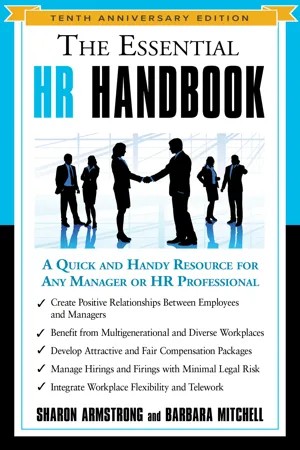
The Essential HR Handbook, 10th Anniversary Edition
Sharon Armstrong, Barbara Mitchell
- 256 páginas
- English
- ePUB (apto para móviles)
- Disponible en iOS y Android
The Essential HR Handbook, 10th Anniversary Edition
Sharon Armstrong, Barbara Mitchell
Información del libro
Since 2008, busy managers by the tens of thousands have turned to this best-selling book as a handy guide to the ins and outs of human resources. And no wonder! Because whether you’re a small business owner, a manager in a business without an HR department, or even a seasoned HR professional, The Essential HR Handbook will help you handle any personnel problem—from onboarding to outplacement—quickly and easily. This fully updated 10th anniversary edition is packed with information, tools, checklists, sample forms, and timely tips to guide you through the maze of personnel issues in today’s complex business environment.
In it you’ll find out how to:
- Attract talented staff through social media recruiting
- Identify legal pitfalls to avoid lawsuits and regulatory interference
- Train a diverse and inclusive multigenerational workforce
- Provide the compensation and benefits package that will make your organization an “employer of choice”
- Streamline your orientation and onboarding practices so new employees hit the ground running
Whenever personnel problems arise, having The Essential HR Handbook on your bookshelf is like having a team of expert HR consultants at your beck and call!
Preguntas frecuentes
Información
1
STRATEGIC HR
with those of its customers and other external shareholders.
Organizational strategy
Developing a strategic plan
- Establish why the organization exists, its mission.
- Define what you want the organization's near future to be.
- Establish what needs to be done—and what needs to be done differently—to reach the stated objectives.
Crafting a mission statement
- What are your plans for growth?
- What is your ethics statement?
- What challenges are you facing today?
- What are your competitors doing that you aren't doing?
- What sets you apart from the competition?
- What changes have occurred in your industry or service area?
- How has globalization affected your organization?
- Have your competitors entered the global market?
- Are there opportunities outside your current market to consider?
- Is your technology up to date?
- What effect has technology had on your customers, members, or employees?
- Have your customers' or members' expectations changed?
- What are you doing to retain any competitive advantage you have?
- What are your distinctive competitive strengths, and how does the plan build on them?
- How will changes in your strategy affect your employees?
- Do you have the people resources you need to reach your desired goals?
- What effect will the changing demographics have on your strategy?
- What legal or regulatory changes do you anticipate that may affect your strategy?
- How and why is this plan different from the previous one? Were all your previous elements completed? If not, why? What could you have done to complete that element?
- How different is your strategy from those of your competitors, and why? Is that good or bad? What do you know about your competitors' strategies?
- How accurate have your past budgets and projections been? What could have made them more accurate and how will you modify your budgeting process, if needed?
- Who will measure the outcomes of the strategy, and with what tools? How often will you monitor progress?
Putting your strategic plan in motion
Communicating the plan
Linking HR planning to the strategic plan
- What are the strengths and areas of concern with the current workforce?
- Who is eligible to retire?
- Are there current employees with performance issues?
- Does the projected growth mean additional workers will be needed?
- What skills and abilities—technical, administrative, managerial, and leadership—are needed to accomplish the work?
- Are there gaps in the current skills of the workforce? What will be required to achieve the new strategic direction?
Índice
- Cover Page
- Title Page
- Copyright
- Dedication
- ACKNOWLEDGMENTS
- CONTENTS
- INTRODUCTION
- 1: STRATEGIC HR
- 2: TALENT ACQUISITION
- 3: ONBOARDING
- 4: TALENT DEVELOPMENT
- 5: PERFORMANCE MANAGEMENT
- 6: BENEFITS
- 7: COMPENSATION
- 8: EMPLOYEE RELATIONS
- 9: LEGAL CONSIDERATIONS
- 10: MANAGING A DIVERSE WORKFORCE
- 11: TECHNOLOGY
- 12: TODAY'S WORKPLACE CHALLENGES
- APPENDIX: ADDITIONAL RESOURCES
- GLOSSARY
- FURTHER READING
- BIBLIOGRAPHY
- NOTES
- INDEX
- ABOUT THE AUTHORS
- Stay Connected with Sharon and Barbara